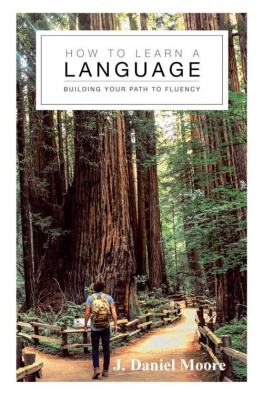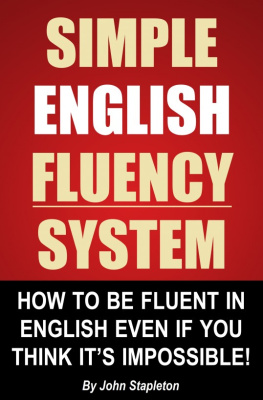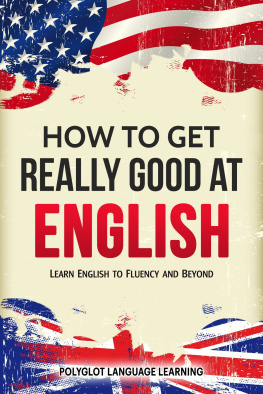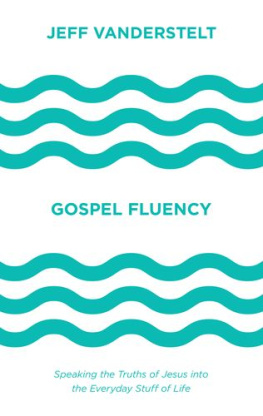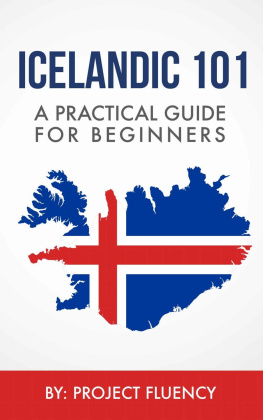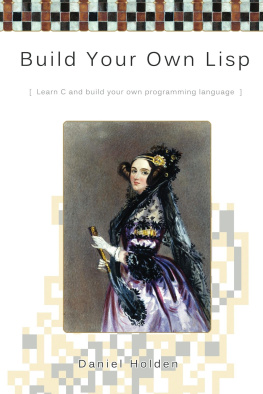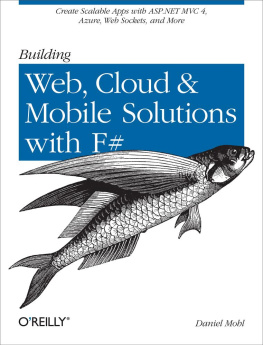J. Daniel Moore - How to Learn a Language: Building Your Path to Fluency
Here you can read online J. Daniel Moore - How to Learn a Language: Building Your Path to Fluency full text of the book (entire story) in english for free. Download pdf and epub, get meaning, cover and reviews about this ebook. year: 2019, genre: Home and family. Description of the work, (preface) as well as reviews are available. Best literature library LitArk.com created for fans of good reading and offers a wide selection of genres:
Romance novel
Science fiction
Adventure
Detective
Science
History
Home and family
Prose
Art
Politics
Computer
Non-fiction
Religion
Business
Children
Humor
Choose a favorite category and find really read worthwhile books. Enjoy immersion in the world of imagination, feel the emotions of the characters or learn something new for yourself, make an fascinating discovery.
- Book:How to Learn a Language: Building Your Path to Fluency
- Author:
- Genre:
- Year:2019
- Rating:4 / 5
- Favourites:Add to favourites
- Your mark:
- 80
- 1
- 2
- 3
- 4
- 5
How to Learn a Language: Building Your Path to Fluency: summary, description and annotation
We offer to read an annotation, description, summary or preface (depends on what the author of the book "How to Learn a Language: Building Your Path to Fluency" wrote himself). If you haven't found the necessary information about the book — write in the comments, we will try to find it.
J. Daniel Moore: author's other books
Who wrote How to Learn a Language: Building Your Path to Fluency? Find out the surname, the name of the author of the book and a list of all author's works by series.
How to Learn a Language: Building Your Path to Fluency — read online for free the complete book (whole text) full work
Below is the text of the book, divided by pages. System saving the place of the last page read, allows you to conveniently read the book "How to Learn a Language: Building Your Path to Fluency" online for free, without having to search again every time where you left off. Put a bookmark, and you can go to the page where you finished reading at any time.
Font size:
Interval:
Bookmark:
How to Learn A Language : Building Your Path to Fluency
Copyright 2019 by J. Daniel Moore
All Rights Reserved
Cover photo by Caleb Jones on Unsplash
Contact info: jdanielmooreauthor@gmail.com
There are seven days in a week and someday isnt one of them. Benny (The Irish Polyglot) Lewis
Language learning is essentially the relentless pursuit of words through reading and listening Steve Kaufmann
Deliberately making mistakes is better than not speaking at all. Donovan Nagel
"Languages cannot be taught. They can only be learned." Luca Lampariello
#AStoryADay Olly Richards
I don't learn languages, I learn people and people connect through sound... Idahosa Ness
Polyglots dont speak many languages because of their special talent but because of the way they learn. Ldia Machov
Table of Contents
Introduction and Getting Started
My heart pounded through my ears, palms sweaty, butterflies swamping my stomach. I was terrified. I had been teaching myself Spanish for a few months without having any idea of how to actually do that and I was about to have my very first attempt at a conversation with a native Spanish speaker on Skype. I took a deep breath as I hit the call button. Im an introvert, so I dont often talk to strangers in English, let alone in a foreign language. Oh God. This was a stupid idea. Why am I doing this? My thoughts raced, trying to outrun my jittery emotions. Within a few seconds, my language exchange partner answered.
Hola! Cmo ests?
Eh, hola, I replied meekly. Um, estoy bien Y t?
Thus my first ever interaction in a foreign language began. Ive repeated this process in Japanese, German, Esperanto, and Portuguese all languages which today I have varying degrees of ability in. When I first started out, and for a long time afterward, I didnt have a clue what I was doing. Through time, experience, experimentation, tips from polyglots, and my own insights as a certified professional ESL (English as a Second Language) teacher who has now given thousands of one-on-one classes, Ive come a very long way. This book is the culmination of everything Ive learned, packaged and presented in a way that is true to reality so that you dont have to wander and stumble lost through the forest like I did.
Who is this Book for?
This book is for everyone those who have never learned a language, those who have tried and failed, and those looking for an extensive guide to improve their own process. Simply put, this book aims to give you a modular approach that you can adapt to fit your goals, needs, and preferences by providing you the tools, resources, techniques, and activities to be able to take charge and succeed in whatever way works best for you. In addition, youll learn various strategies you can apply and paths you can follow or modify if desired.
Everyone learns similarly in some respects, but differently in other respects, and not everyone enjoys the same types of activities or has the same goals. So, the purpose of this book is to allow you to find the best way that you personally learn a language and fit it to suit your needs. As much as one might hate to admit it, there is no right way to learn a language, only the way that works best for you (although there are some general principles and considerations, which well see later).
If you have no experience with language learning, dont fret. This book is full of not only activities and resources, but guidance as well.
How to Use this Book
This book is made up of different parts. The first part is an introduction, which provides a lot of important information to prepare you for the journey ahead. The next part is what I call the paths. The paths provide the general frameworks for your own personal approach as you move forward in your language learning journey. Think of it like a map or guide of sorts. Included in the paths section are: the two general big-pillar paths, other particular paths, how to create your own path, and various strategies.
The part after that is about the five language learning skills: speaking, reading, writing, listening, and pronunciation. Theres an introduction, which contains some nice graphics for you to observe my art skills and, more importantly, to help you visualize how all the skills work together and fit into the big picture of language learning. Then each skill has its own chapter, with the exception of reading and listening, which I grouped together.
Each skill chapter contains general and useful information that you need to know about the skill, followed by all the various tools, resources, techniques, and activities that you can utilize. There will be information about each of these and how to use/do them, but you dont have to use or do all of them. Its merely a reference of things that you can try out if you find them useful, interesting, and/or fun. NOTE : make sure that you dont skip any of the information in the chapter introductions as much of it is important information, especially if youre going to create your own path or tweak an existing one.
The final part is about the two knowledge areas of grammar and vocabulary. These follow the same format as the previous part: general and important information followed by the tools, resources, techniques, and activities that you can utilize. Note that although Ive divided the book between the skill areas chapters and the knowledge areas chapters, it can be useful to jump around as needed. For example, after you read about the paths, you might want to jump to the vocabulary chapter to determine what approach to vocabulary youd prefer.
After exploring all the various areas of language learning, Ive also included an outline called Putting it All Together which takes you step-by-step through the process of implementing everything in this book into one complete, personalized system. As a bonus, I also give you two detailed examples of putting everything together using those steps in real life scenarios.
Id also like to recommend that as you go through each chapter, highlight or mark resources and activities that appeal to you. This will help you a lot when we get to the Putting it All Together part at the end. In fact, after reading this introduction chapter, you might want to briefly skim that chapter to get a better idea of the whole before diving into each of the pieces that make up the rest of the book.
At the very end of the book are a few appendices. These contain varied and useful information to further assist you in your language learning endeavor.
Why Youve Failed in the Past
For those who have never tried to learn a foreign language, you can skip this part if you want, but it might be good to read it, anyway. It can give you some insight into what to expect and what not to do in the future.
If youve tried to learn a language before, you know how frustrating it can be. Maybe you took four years of Spanish in school and then found out that you couldnt even hold a basic conversation after all of your hard work and good grades. This is the cardinal mistake of every inexperienced language learner. In fact, a number of polyglots (people who speak multiple languages) did horrible in school with languages. A big part of the problem is that the way schools teach is highly ineffective for anything other than grammar. Even then, theres a big difference between understanding something logically and being able to effectively use it.
Modern teaching approaches are getting better, which I can attest to after taking a Portuguese class on a whim in 2017. However, traditional classes are still very ineffective, not organized properly, and the progress is unnecessarily slow. I dropped out of that Portuguese class after about two months. I could have easily taught myself that two months worth of material in one or two weeks because it was so slow and ill-organized. And thats one of the keys to successfully learning a language, as well as one of the main principles of this book: a language (like any skill) isnt something that someone can give you, its something that you have to take into your own hands .
Next pageFont size:
Interval:
Bookmark:
Similar books «How to Learn a Language: Building Your Path to Fluency»
Look at similar books to How to Learn a Language: Building Your Path to Fluency. We have selected literature similar in name and meaning in the hope of providing readers with more options to find new, interesting, not yet read works.
Discussion, reviews of the book How to Learn a Language: Building Your Path to Fluency and just readers' own opinions. Leave your comments, write what you think about the work, its meaning or the main characters. Specify what exactly you liked and what you didn't like, and why you think so.

